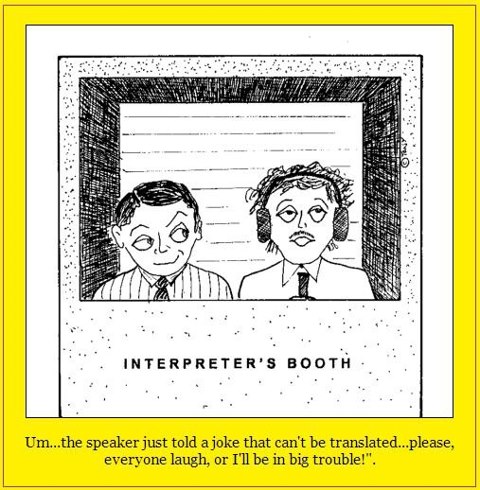Do you want to please your interpreters? So come learn how to be a good client for them.
“Wow, you guys are miracle workers, I can’t imagine how you manage to do that!”
I must cofess that more than one high skilled professional (fluent in more than one foreign language) has already said that to me. And it always makes me fell flattered, but surprised.
Although thinking back when I was an undergraduate, the first time I saw a translation booth being used during a lecture, I just didn’t have the guts to try it myself – and my major was Translation Studies.
Let’s face it, it’s a huge responsibility to be the voice in another language of that guy there on the front, the one who’s talking about what everyone wants to know.
And yes, it’s way difficult. Plus, some folks manage to make our lives even harder.
Thus, inspired by Number 17, I decided to write a good manners handout for clients of simultaneous interpreting. Maybe if they learn a bit more about our job, they will learn how to be a good client from now on.
1. Behave yourself
I know, I know, the booth is something peculiar, so interesting for someone who has never seen anything like it. But hey – we are no mermaids and this is not a fish tank.
That being said. never knock on the glass to call the interpreter’s attention, no matter the reason. Simultaneous translation demands concentration above regular levels, plus standard conditions for temperature and pressure – soundproofing being one of the major issues.
Do you desperatly need to talk to the interpreters? Talk to the one who’s off the mic at the moment, asking him/her to leave the booth or sending them a written note. Remember, every sound in the booth is captured by the microphone.
2. Get out of the way
Don’t obstruct the view of those inside the booth. Simultaneous translation is much easier once we can see the one who is speaking -–believe me, reading their body language is of great help.
Although this is not a general rule, booths tend to be in unfavourable positions, usually in the back of the room – having an extra head in front of us is no help at all. Unfortunately, not every booth is like the dreamy European Parliament ones.
Now for some tips specifically to the speaker…
3. Speak on the mic
We are only able to translate you if you speak on the mic – we are all the way back there, remember? Even if you speak loud, we are most likely not to hear you clearly.
The same works for the Q&A session. Please ask everyone to speak on the mic or we will have to ask those who are actually listening to us and most of the time, this is not fun at all.
4. Reading anything?
Are you going to read during your lecture? So please send the interpreters this piece of writing in advance. Why? Easy, people tend to speak faster while reading, and that makes our work so much more difficult, you have no idea. Now when we get the text in advance, we can make notes of technical terms of difficult translation and have an idea of what’s ahead of us. It’s way helpful, please consider that next time.
5. Plan ahead
If you want to be a good client for real, providing any sort of reading material in advance will be of great help to us interpreters. Before any kind of presentation, we organize glossaries, do some reasearch on the specific vocabulary, that is, give our best. Or did you really think we happen to know how to translate ‘foot bath’ just because?


